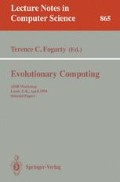Abstract
Techniques to investigate chaotic data require long noisefree series. Genetic programming allows fitting of arbitrary functions to short noisy datasets. Conventional genetic programming was used to fit Lisp S-expressions to a known chaotic series (the Mackey-Glass equation, discretized to a map) with added noise. Embedding was performed by including previous values in time in the terminal set. Prediction intervals were 20–1065 steps into the future, based upon near-minimal 35 ‘training’ points from the series.
Fittest S-expressions yielded useful structural information. Semilogarithmic plots of normalised root mean squared error of the fittest forecasts against the length of forecast showed two dominant slopes. Noise led to a small exponential increase in this error. Genetic programming appears useful, as it compares favourably with established techniques, is robust to noise, and easily avoids overfitting.
Preview
Unable to display preview. Download preview PDF.
References
Casdagli, M.: Nonlinear prediction of chaotic time series. Physica D 35 (1989) 335–356
Casdagli, M.: Chaos and deterministic versus stochastic non-linear modelling. J. R. Statist. Soc. B 54 (1991) 303–328
Casdagli, M., des Jardins, D., Eubank, S., Farmer, J. D., Gibson, J., Theiler, J.: Nonlinear modelling of chaotic time series: theory and applications. In Kim, J. H., Stringer, J. (Eds.): Applied Chaos. New York, NY: Wiley-Interseience (1992)
Farmer, J. D., Sidorowich, J. J.: Predicting chaotic time series. Phys. Rev. Lett. 59 (1987) 845–848
Glass, L., Kaplan, D.: Time series analysis of complex dynamics in physiology and medicine. Proceedings of NATO Workshop on Comparative Time Series Analysis held at the Santa Fe Institute, 14–17 May 1992
Grassberger, P., Procaccia, I.: Measuring the strangeness of strange attractors. Physica 9D (1983) 189–208
Koza, J. R.: Genetic Programming. On the Programming of Computers by Means of Natural Selection. Cambridge, MA: MIT Press (1992)
Mackey, M. C., Glass, L.: Oscillation and chaos in physiological control systems. Science 197 (1977) 287–289
Mead, W. C., Jones, R. D., Lee, Y. C., Barnes, C. W., Flake, G. W., Lee, L. A., O'Rourke, M. K.: Prediction of chaotic time series using CNLS-net — example: the Mackey-Glass equation. In Casdagli, M., Eubank, S. (Eds.): Nonlinear Modelling and Forecasting. Redwood City, CA: Addison-Wesley (1992)
Meyer, T. P., Packard, N. H.: Local forecasting of high-dimensional chaotic dynamics. In Casdagli, M., Eubank, S. (Eds.): Nonlinear Modelling and Forecasting. Redwood City, CA: Addison-Wesley (1992)
Nychka, D., Ellner, S., Gallant, A. R., McCaffrey, D.: Finding chaos in noisy systems. J. R. Statist. Soc. B 54 (1992) 399–426
Oakley, E. H. N.: Two scientific applications of genetic programming: the development of stack filters, and the fitting of non-linear equations to chaotic data. In Kinnear, K. (Ed.): Advances in Genetic Programming. Cambridge, MA: MIT Press (1994)
Ruelle, D.: Deterministic chaos: the science and the fiction. Proc. Roy. Soc. Lond. A 427 (1990) 241–248
Stokbro, L., Umberger, D. K.: Forecasting with weighted maps. In Casdagli, M., Eubank, S. (Eds.): Nonlinear Modelling and Forecasting. Redwood City, CA: Addison-Wesley (1992)
Author information
Authors and Affiliations
Editor information
Rights and permissions
Copyright information
© 1994 Springer-Verlag Berlin Heidelberg
About this paper
Cite this paper
Howard, E., Oakley, N. (1994). The application of genetic programming to the investigation of short, noisy, chaotic data series. In: Fogarty, T.C. (eds) Evolutionary Computing. AISB EC 1994. Lecture Notes in Computer Science, vol 865. Springer, Berlin, Heidelberg. https://doi.org/10.1007/3-540-58483-8_24
Download citation
DOI: https://doi.org/10.1007/3-540-58483-8_24
Published:
Publisher Name: Springer, Berlin, Heidelberg
Print ISBN: 978-3-540-58483-4
Online ISBN: 978-3-540-48999-3
eBook Packages: Springer Book Archive

